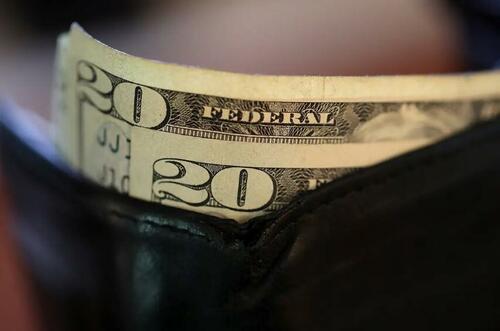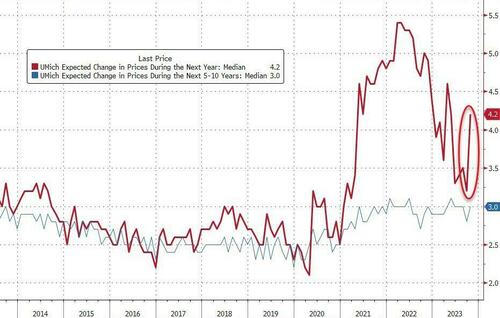Survey Found Most Americans Falling Behind On Emergency Savings
Authored by Aaron Pan via The Epoch Times,
The survey found that 60 percent of Americans are falling behind on their savings for emergencies, in which 38 percent said they are significantly behind…
A large majority of Americans are falling behind on their savings, as 81 percent have not increased their emergency savings since the beginning of the year, according to a survey.
The survey by Bankrate, released on Oct. 25, showed just 19 percent of American households increased their emergency savings, while 32 percent have less savings now compared with the beginning of 2023. Thirty percent of households have the same amount of savings, while 20 percent had no emergency savings at the start of the year and remain having none.
In terms of age, older generations tend to have less emergency savings now than at the beginning of the year.
According to the survey, households with income over $100,000 tend to have more savings now than at the beginning of the year.
In addition, the survey found that 60 percent of Americans are falling behind on their savings for emergencies, in which 38 percent said they are significantly behind and 22 percent said they are slightly behind.
Among those who said they were falling short on their savings, 13 percent said they would never be on track, while 22 percent said they were uncertain how long it would take.
The poll also found inflation is the main impediment that prevents Americans from increasing their savings amid renewed concern over long-term price hikes. Fifty-seven percent of households who suffered no saving increase blamed inflation for their issue, while 38 percent cited too many expenses that hurt their saving funds.
“Just 19 percent have increased their emergency savings balances since the beginning of the year. Rising prices and high household expenses have been the predominant impediments to boosting emergency savings,” said Bankrate chief financial analyst Greg McBride.
The survey was conducted online with 2,496 adults from Sept. 20 to 22.
Tap Savings for Consumption
The Federal Reserve Bank of New York revealed on Oct. 11 that Americans’ disposable income has fallen, and consumers are increasingly dipping into savings to prop up consumption.
From the beginning of the pandemic in 2020 through the end of 2021, Americans’ excess savings grew to roughly $2.6 trillion, or 14 percent of annual disposable income, according to the New York Fed.
Since then, U.S. excess savings have steadily fallen, dropping to 10 percent of disposable income—or $1.9 trillion—by the second quarter of 2023.
Data for the first two months of the third quarter cited by the New York Fed show that consumers have generally maintained their propensity to spend, but as real disposable income has fallen, they’ve increasingly been drawing on their savings to continue shopping.
Withdrawals From Retirement Savings on the Rise
Amid persistent inflation, retirement savings also take a hit as more Americans make hardship withdrawals from their retirement funds to cover emergency needs.
USA Today cited a report from Fidelity Investments, reporting that hardship withdrawals from 401(k) accounts have tripled from 2.1 percent in 2018 to 6.9 percent in 2023.
Moreover, hardship withdrawals at Vanguard have doubled during the 2018-2022 period, increasing from a monthly rate of 2.1 transactions per 1,000 participants in 2018 to 4.3 in 2022.
Inflation Eroding Living Standards
Nearly 50 percent of Americans say high prices are eroding their living standards—a record number that matched the all-time high set in July 2022, when the pace of inflation was a whisker away from breaking into the double digits.
“After stabilizing earlier this year, concerns about inflation have grown again,” reads the latest University of Michigan Surveys of Consumers report, released on Oct. 13.
The survey shows that 49 percent of consumers polled in early October said high prices eroded their living standards. That’s up substantially from last month’s 39 percent and matches the all-time high notched in July 2022.
Inflation, as measured by the Consumer Price Index (CPI), shot up at a furious pace through 2021 and narrowly missed breaking the 10 percent psychological barrier by mid-2022.
The rising prices peaked at 9 percent in June 2022, a multi-decade high that later fell to 3.1 percent by June 2023. However, inflation in August and September jumped back up to 3.7 percent, bringing renewed concerns about inflation.
What’s more, year-ahead inflation expectations have jumped, rising from 3.2 percent in September to 3.8 percent in early October, per the University of Michigan survey.
Longer-term inflation expectations also rose to 3 percent this month from 2.8 percent last month.
Tyler Durden
Mon, 10/30/2023 – 06:30
via ZeroHedge News https://ift.tt/ndE2u8D Tyler Durden

